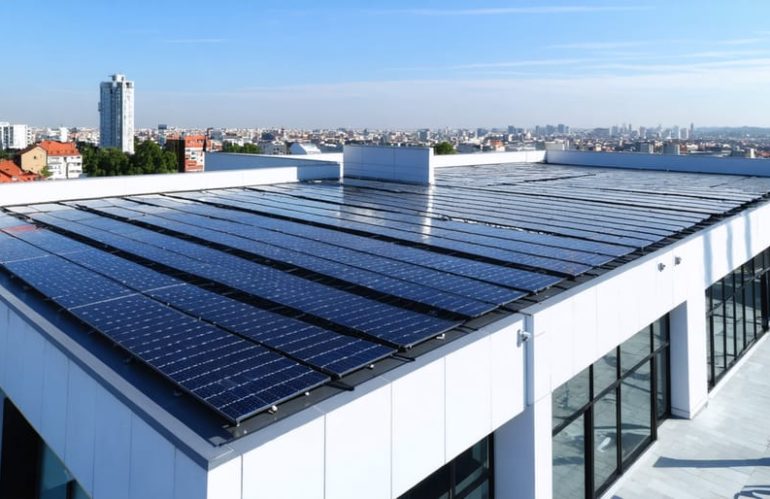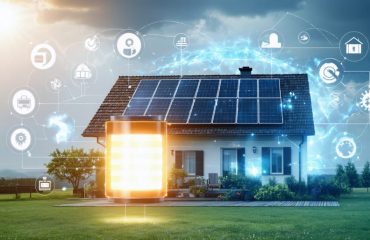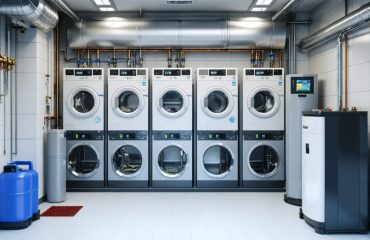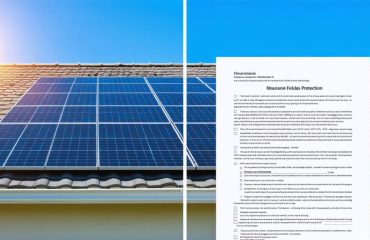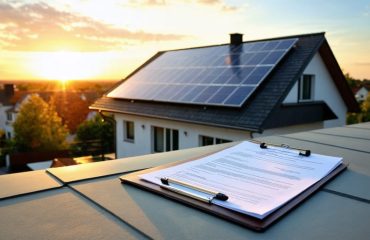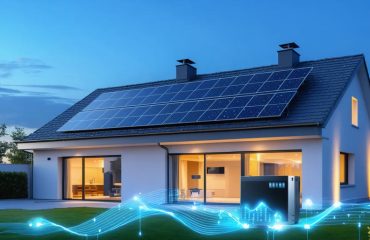Transform your commercial building into a sustainable powerhouse with rooftop solar installations that deliver immediate returns on investment. Modern solar technology has revolutionized how businesses approach energy management, offering 25-30% reduction in operational costs while increasing property values by up to 20%. While commercial solar installation costs have decreased by 65% over the past decade, the real value lies in long-term energy independence and environmental leadership.
Smart building owners are capitalizing on unused roof space to generate clean, renewable energy while benefiting from federal tax incentives, accelerated depreciation, and state-specific renewable energy credits. With commercial buildings consuming nearly 35% of electricity in major cities, rooftop solar installations represent a crucial opportunity to reduce carbon footprints while strengthening bottom lines.
Today’s commercial solar solutions integrate seamlessly with existing building management systems, offering real-time monitoring, predictive maintenance, and sophisticated energy storage options. These systems not only protect against rising utility costs but also position businesses as environmental leaders in their communities, attracting environmentally conscious tenants and customers.
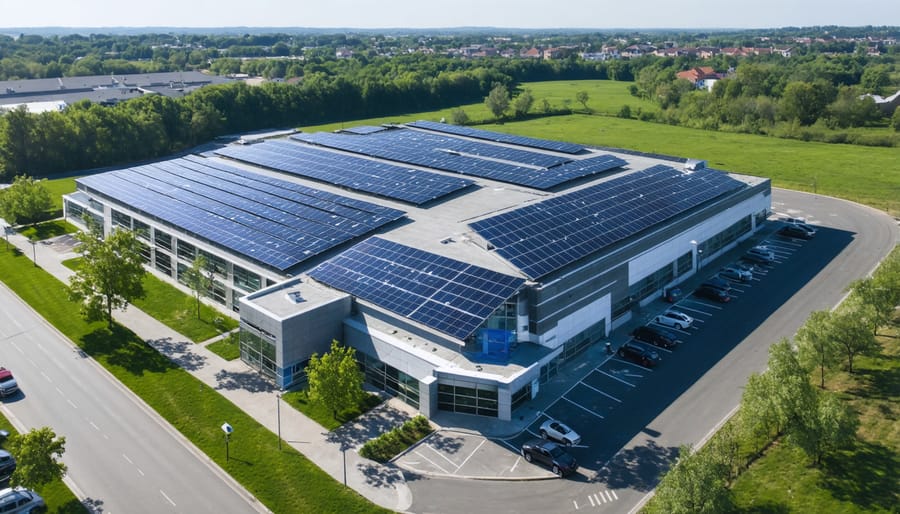
Essential Protection Policies for Commercial Rooftop Solar
Insurance Coverage Requirements
When installing rooftop solar systems on commercial buildings, proper solar panel insurance coverage is essential to protect your investment. Most commercial property insurance policies need to be updated to specifically include solar installations, typically requiring both property and liability coverage.
Property coverage should protect against physical damage from events like storms, fire, and vandalism, with coverage limits matching the full replacement value of the system. We recommend coverage of at least $25,000 per 10kW of installed capacity. Liability insurance should cover potential damages to third parties, with minimum coverage of $1 million recommended for most commercial installations.
Business interruption insurance is also crucial, as it covers potential revenue losses if system damage leads to operational disruptions. This coverage should account for both lost energy production and any impact on business operations dependent on solar power.
Professional liability insurance is necessary for installation contractors, with minimum coverage of $2 million typically required. Building owners should verify this coverage before installation begins. Additionally, worker’s compensation insurance must be maintained to cover any injuries during installation or maintenance.
Many insurers offer specialized renewable energy coverage packages that bundle these protections together. These packages often include additional benefits like coverage for environmental cleanup costs and equipment breakdown protection. When selecting coverage, work with insurers experienced in commercial solar installations to ensure all potential risks are adequately addressed. Regular policy reviews are recommended as system values and risk factors may change over time.
Warranty Protection Guidelines
Understanding warranty protection is crucial to protect your solar investment in commercial rooftop installations. Most solar panel manufacturers offer product warranties ranging from 10 to 25 years, covering defects in materials and workmanship. These warranties typically guarantee that panels will maintain at least 80% of their original power output capacity after 25 years.
Installation warranties, provided by your solar contractor, typically cover workmanship for 5 to 10 years. This includes protection against issues arising from improper installation, mounting system failures, and damage to your building’s roof or structure during installation. It’s essential to work with certified installers who offer comprehensive warranty coverage and maintain proper documentation.
Key warranty components to look for include:
– Performance guarantee warranty
– Product warranty covering manufacturing defects
– Inverter warranty (usually 10-15 years)
– Mounting system warranty
– Workmanship warranty from the installer
To maintain warranty validity, ensure regular maintenance is performed by qualified professionals and keep detailed records of all inspections and repairs. Many warranties require annual inspections and proper documentation of maintenance activities. Be aware that certain modifications or repairs by unauthorized personnel may void your warranty coverage.
Consider working with solar providers who offer warranty insurance or third-party warranty backing, which provides additional protection if the original manufacturer goes out of business. Always read warranty terms carefully and understand exclusions, claim procedures, and transferability options if you sell your property.
Physical Protection Systems
Weather Protection Systems
Modern commercial solar installations come equipped with robust weather protection systems designed to safeguard your investment against nature’s challenges. These systems typically include heavy-duty mounting hardware that keeps panels securely fastened during high winds, while specialized rain barriers prevent water damage and potential leaks around mounting points.
Most installations feature lightning protection systems that safely channel electrical surges away from your solar equipment and building. Advanced hail guards and reinforced glass panels provide excellent protection against impact damage, with many systems rated to withstand hailstones up to one inch in diameter.
Snow management systems are particularly important in colder climates. These include specialized panel coatings that promote snow sliding and heating elements that prevent ice dam formation. Some systems also incorporate wind deflectors that help minimize snow accumulation while reducing wind uplift forces on the array.
Temperature regulation systems help maintain optimal panel performance across extreme weather conditions. These include proper ventilation designs that allow air circulation beneath the panels, reducing heat buildup in summer and preventing moisture accumulation in winter.
To ensure maximum protection, these systems work together with monitoring technology that alerts building managers to potential issues before they become problems. Regular maintenance checks and seasonal adjustments help keep these protective measures working effectively year-round, maximizing both the safety and efficiency of your solar investment.
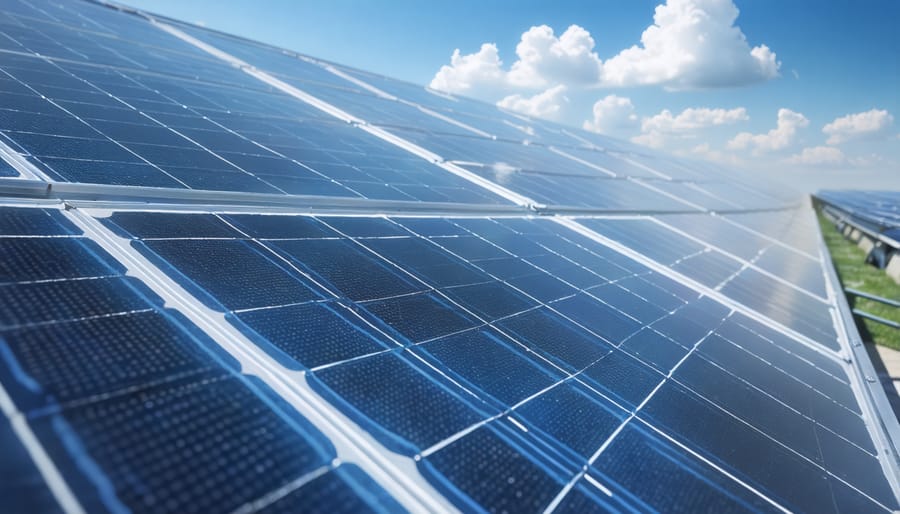
Security Measures
Protecting your rooftop solar investment is crucial for long-term success and peace of mind. Modern solar installations come with several built-in security features to prevent theft and vandalism. Anti-theft mounting systems use specialized one-way bolts and security fasteners that make panel removal extremely difficult without specific tools. Many systems also include tamper-evident indicators that show signs of attempted manipulation.
Smart monitoring systems provide real-time alerts if panels are disconnected or disturbed, allowing for immediate response to potential security breaches. These systems can be integrated with existing building security cameras and alarm systems for comprehensive protection. Additionally, GPS tracking devices can be installed within the solar array to assist in recovery if theft occurs.
Physical deterrents like security lighting, motion sensors, and protective barriers around roof access points significantly reduce the risk of unauthorized access. Many building owners also opt for security cameras specifically aimed at their solar installations, often equipped with night vision capabilities.
Insurance policies specifically designed for solar installations provide additional protection against theft, vandalism, and damage. Regular maintenance inspections can identify potential security vulnerabilities before they become problems. Consider implementing access control measures for maintenance personnel and keeping detailed records of all system interactions.
Remember that visible security measures often serve as effective deterrents, preventing incidents before they occur. Working with your solar installer to develop a comprehensive security strategy ensures your investment remains protected for years to come.
Maintenance and Monitoring Protocols
Regular Inspection Requirements
Regular inspections are essential for maintaining the performance and longevity of your commercial rooftop solar installation. Schedule comprehensive inspections at least twice yearly, ideally in spring and fall, to ensure optimal system functionality and comply with solar panel insurance requirements. These inspections should include:
Visual checks for physical damage, loose connections, and debris accumulation
Performance monitoring to identify efficiency drops
Electrical system testing
Mounting hardware assessment
Cleaning of panels and surrounding areas
Create a maintenance checklist that building maintenance staff can follow between professional inspections. This should include monthly visual inspections from accessible vantage points and monitoring system performance data. After severe weather events, conduct additional inspections to check for storm damage.
Keep detailed records of all inspections, maintenance activities, and repairs. This documentation helps track system performance over time and can be valuable for warranty claims or insurance purposes. Many modern solar installations include monitoring systems that can alert you to potential issues between scheduled inspections, helping prevent costly repairs and maintain optimal energy production.
Performance Monitoring Systems
Modern performance monitoring systems are essential for getting the most out of your commercial rooftop solar installation. These smart systems use a combination of sensors and software to track your solar panels’ energy production in real-time, helping you spot and fix issues before they impact your bottom line.
Most monitoring solutions include user-friendly dashboards that display key metrics like daily energy generation, cost savings, and system health. You can access this information through web portals or mobile apps, making it easy to check your system’s performance anywhere, anytime.
Advanced monitoring features can alert you to potential problems like damaged panels, connection issues, or unexpected drops in energy production. Some systems even use artificial intelligence to predict maintenance needs and optimize panel performance based on weather patterns and historical data.
Many monitoring solutions also generate detailed reports that help track your return on investment and verify warranty compliance. This data is particularly valuable for building managers who need to demonstrate the financial benefits of their solar investment to stakeholders.
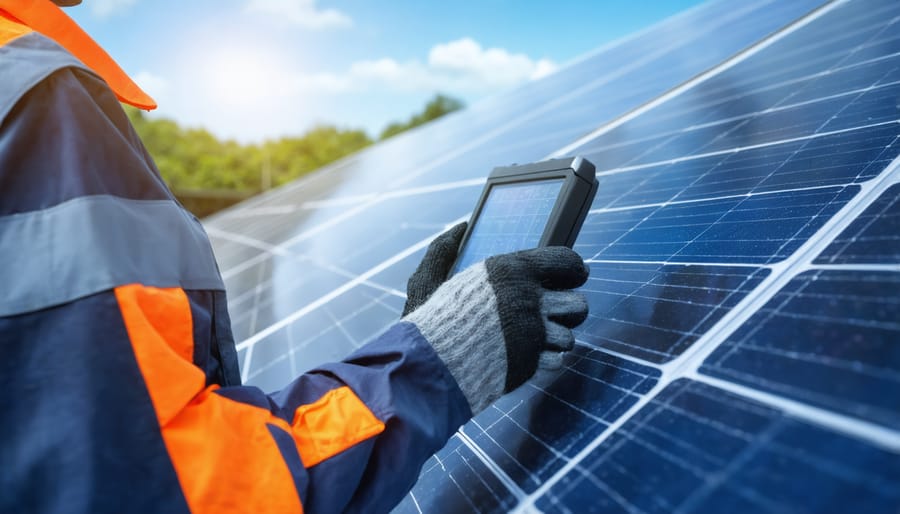
Implementing comprehensive protection policies for rooftop solar installations on commercial buildings is not just a safety measure – it’s a smart business decision that pays dividends for years to come. By combining proper insurance coverage, robust warranties, regular maintenance protocols, and physical protection measures, building owners can significantly extend the lifespan of their solar investment while maximizing energy production and cost savings.
The key to success lies in taking a proactive approach. Regular inspections, timely maintenance, and staying current with warranty requirements ensure your system operates at peak efficiency while maintaining its value. Additionally, having the right insurance coverage protects against unexpected events and provides peace of mind for property owners and stakeholders.
Remember that solar installations are long-term investments that can deliver returns for 25 years or more when properly protected. The initial effort of establishing comprehensive protection policies may require some upfront planning, but the resulting benefits – including reduced operational costs, increased property value, and enhanced environmental sustainability – make it well worth the investment. By implementing these protective measures today, you’re securing your solar investment for decades to come.

